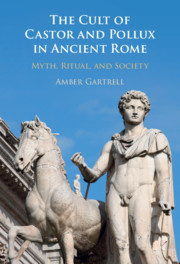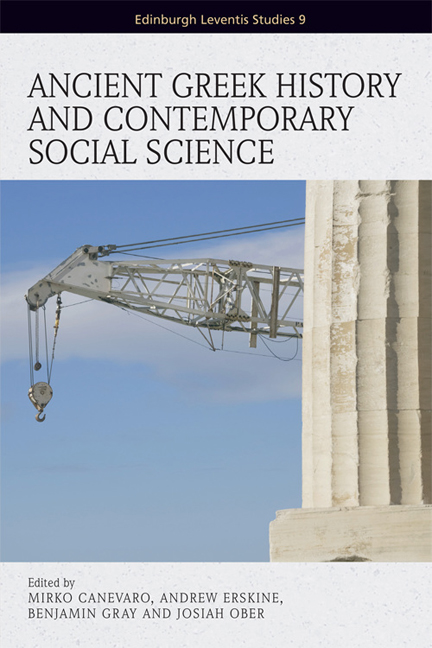Refine search
Actions for selected content:
23990 results in Ancient history

A Social and Economic History of the Theatre to 300 BC
-
- Published online:
- 20 May 2021
- Print publication:
- 16 January 2020

The Cult of Castor and Pollux in Ancient Rome
- Myth, Ritual, and Society
-
- Published online:
- 08 May 2021
- Print publication:
- 29 April 2021

Ancient Greek History and Contemporary Social Science
-
- Published by:
- Edinburgh University Press
- Published online:
- 06 May 2021
- Print publication:
- 06 June 2018

Revenge and Gender in Classical, Medieval and Renaissance Literature
-
- Published by:
- Edinburgh University Press
- Published online:
- 06 May 2021
- Print publication:
- 15 May 2018
Frontmatter
-
- Book:
- The Roman Republic to 49 BCE
- Published online:
- 22 June 2021
- Print publication:
- 06 May 2021, pp i-vi
-
- Chapter
- Export citation
Glossary
-
- Book:
- The Roman Republic to 49 BCE
- Published online:
- 22 June 2021
- Print publication:
- 06 May 2021, pp 207-210
-
- Chapter
- Export citation
Maps
-
- Book:
- The Roman Republic to 49 BCE
- Published online:
- 22 June 2021
- Print publication:
- 06 May 2021, pp xix-xix
-
- Chapter
- Export citation
Abbreviations
-
- Book:
- The Roman Republic to 49 BCE
- Published online:
- 22 June 2021
- Print publication:
- 06 May 2021, pp xxxvi-xxxviii
-
- Chapter
- Export citation
Read This First!
-
- Book:
- The Roman Republic to 49 BCE
- Published online:
- 22 June 2021
- Print publication:
- 06 May 2021, pp 1-4
-
- Chapter
- Export citation
Acknowledgments
-
- Book:
- The Roman Republic to 49 BCE
- Published online:
- 22 June 2021
- Print publication:
- 06 May 2021, pp xxviii-xxix
-
- Chapter
- Export citation
Notes
-
- Book:
- The Roman Republic to 49 BCE
- Published online:
- 22 June 2021
- Print publication:
- 06 May 2021, pp 211-239
-
- Chapter
- Export citation
Figures
-
- Book:
- The Roman Republic to 49 BCE
- Published online:
- 22 June 2021
- Print publication:
- 06 May 2021, pp xi-xviii
-
- Chapter
- Export citation
3 - Mutinies?
-
- Book:
- The Roman Republic to 49 BCE
- Published online:
- 22 June 2021
- Print publication:
- 06 May 2021, pp 114-161
-
- Chapter
- Export citation
Bibliography
-
- Book:
- The Roman Republic to 49 BCE
- Published online:
- 22 June 2021
- Print publication:
- 06 May 2021, pp 240-265
-
- Chapter
- Export citation
2 - Monuments
-
- Book:
- The Roman Republic to 49 BCE
- Published online:
- 22 June 2021
- Print publication:
- 06 May 2021, pp 60-113
-
- Chapter
- Export citation
Coin Types Illustrated
-
- Book:
- The Roman Republic to 49 BCE
- Published online:
- 22 June 2021
- Print publication:
- 06 May 2021, pp xxi-xxvii
-
- Chapter
- Export citation
Boxes
-
- Book:
- The Roman Republic to 49 BCE
- Published online:
- 22 June 2021
- Print publication:
- 06 May 2021, pp xx-xx
-
- Chapter
- Export citation
1 - Money
-
- Book:
- The Roman Republic to 49 BCE
- Published online:
- 22 June 2021
- Print publication:
- 06 May 2021, pp 5-59
-
- Chapter
- Export citation
4 - Mobilization
-
- Book:
- The Roman Republic to 49 BCE
- Published online:
- 22 June 2021
- Print publication:
- 06 May 2021, pp 162-202
-
- Chapter
- Export citation
Dedication
-
- Book:
- The Roman Republic to 49 BCE
- Published online:
- 22 June 2021
- Print publication:
- 06 May 2021, pp vii-viii
-
- Chapter
- Export citation
